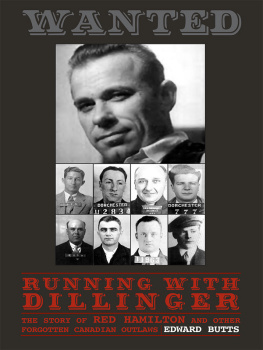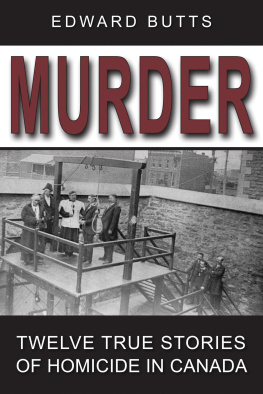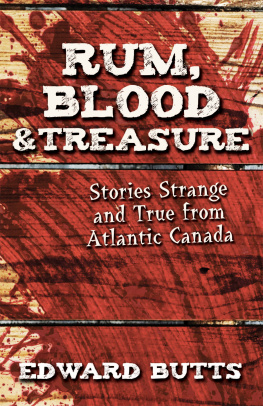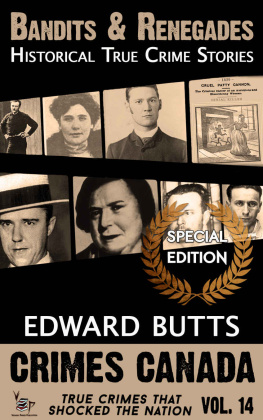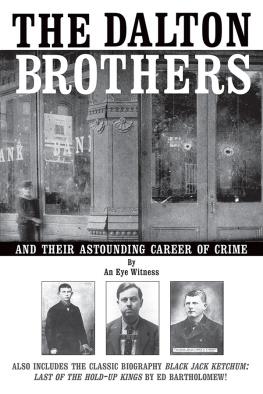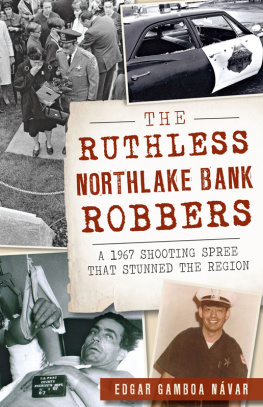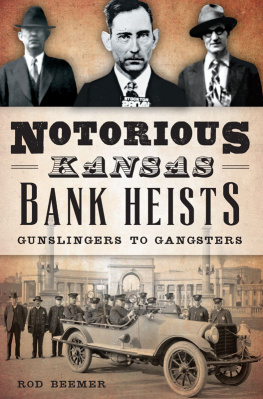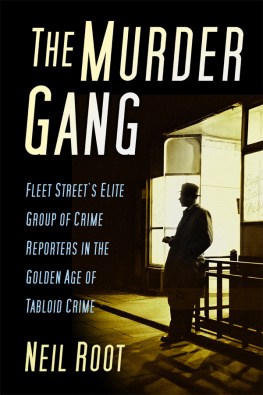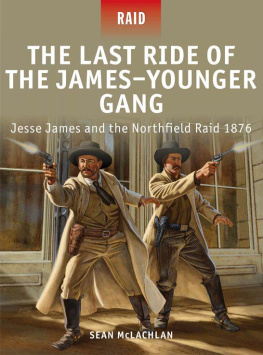I would like to express my appreciation to the many people and institutions who assisted me in researching and writing this book: Michael Carroll and Shannon Whibbs of Dundurn; Edward (Ted) and Jane Cobean and the Brocton Heritage Committee; Monica Graham; A.E. Dalton; Peter Edwards; the Colorado Historical Society; the Metropolitan Toronto Reference Library; the Rooms of St. Johns, Newfoundland and Labrador; the Ontario Provincial Archives; the Alberta Provincial Archives; Pinkertons Inc.; the Walkerton Public Library; Library and Archives Canada; Mary Moriarty, Damien Rodden, Kingston Penitentiary Museum; and as always the staff of the Guelph Public Library.
Bibliography
Books
Bjorkman, Timothy W. Verne Sankey: Americas First Public Enemy . Norman, OK: University of Oklahoma Press, 2007.
Campbell, Marjorie Freeman. A Century of Crime . Toronto: McClelland & Stewart, 1970.
Edwards, Peter and Michel Auger. The Encyclopedia of Canadian Organized Crime . Toronto: McClelland & Stewart, 2004.
English, John. The Worldly Years: The Life of Lester Pearson, 19491972 . Toronto: Alfred A. Knopf Canada, 1992.
Fitzgerald, Jack. Too Many Parties, Too Many Pals . St. Johns, NL: Jesperson Press, 1982.
____. Rogues & Branding Irons . St. Johns, NL: Jesperson Press, 1987.
____. The Hangman is Never Late . St. Johns, NL: Creative Publishers, 1999.
Graham, Monica. The Great Maritime Detective . Halifax: Nimbus Publishing, 2009.
Granatstein, J.L. Canada 19571967: The Years of Uncertainty and Innovation . Toronto: McClelland & Stewart, 1986.
Gwyn, Richard. The Shape of Scandal: A Study of a Government in Crisis . Toronto: Clark, Irwin & Company, 1965.
Helmer, William J. and Rick Mattix. The Complete Public Enemy Almanac . Nashville: Cumberland House, 2007.
MacIntyre, N. Carroll. The Life & Adventures of Detective Peter Owen Carroll . Antigonish, NS: Sundown Publications, 1985.
McArthur, Micky. Id Rather Be Wanted Than Had: The Memoirs of an Unrepentant Bank Robber . Toronto: Stoddart Publishing, 1990.
Moriarty, Mary. Kenneth Daniel Green: Polka Dot Gang Leader. Unpublished essay.
Newton, Willis and Joe (with Claude Stanush and David Middleton). The Newton Boys: Portrait of an Outlaw Gang . Abilene, TX: State House Press, McMurray University, 1994.
ONeill, Paul. A Seaport Legacy: The Story of St. Johns, Newfoundland . Erin, ON: Press Porcepic, 1975.
Thomas, Jocko. From Police Headquarters: True Tales from the Big City Crime Beat . Toronto: Stoddart Publishing, 1990.
Newspapers
Guelph Mercury
Kingston Whig-Standard
Montreal Gazette
Orillia Packet and Times
Owen Sound Sun Times
Port Perry Star
Toronto Globe and Mail
Toronto Star
Toronto Telegram
Vancouver Province
Walkerton Herald-Times
Periodicals
Ernst, Donna B. The Sundance Kid in Alberta. Alberta History (Autumn 1994).
Newman, Peter C. Weve Seen This Before: Forty Years Ago, Scandal Shook Another Liberal Minority Government. Macleans (April 27, 2005).
Chapter 1
Newfoundland Desperadoes:
A Rogues Gallery
T he recorded history of the province of Newfoundland and Labrador is the oldest of any part of Canada, predating even the earliest documented use of the word Canada . Lawlessness on the island of Newfoundland began early in the seventeenth century, when it was a base for pirates like Peter Easton and Henry Mainwaring. Later, the interior became a haven for the outlawed Masterless Men, escaped indentured servants and Royal Navy deserters who sought freedom in the wild.
Throughout their long colonial period, Newfoundlanders were subject to the same harsh laws as the common people of Britain. In the earliest years, the usual punishment for theft was hanging. It didnt matter if the culprit had stolen a few shillings or a cow. In time, the number of crimes punishable by death was reduced, but penalties were still severe. They included whipping, branding with a hot iron, banishment, and the confiscation of property.
In 1777, for example, Lawrence Hallohan was hanged for forging a bill for eight pounds. That same year, Lawrence Dalton followed him to the gallows for forging bills for twenty shillings and seventeen shillings. However, when Patrick Knowlan was convicted of stealing an item valued at ten pence, he wasnt sentenced to hang. Instead, he had a halter put around his neck and was dragged to whipping posts set up at various locations in St. Johns where he was given a total of sixty lashes on his back by the common whipper. He forfeited all of his goods and property, was obliged to pay the court costs, and then was banished from the colony forever. If he returned to Newfoundland, he would be imprisoned and subjected to sixty lashes every Monday until passage on a ship could be found for him.
Offences such as public drunkenness, disorderly conduct, or sticking your tongue out at your employer could result in lashes or a day locked in the stocks, where you were an object of ridicule and the target for all the manure and other filth passersby wanted to throw at you. Most of the individuals subjected to these harsh punishments could hardly be considered hardened criminals. The existence of such measures is far more telling of the legal system that applied them than of the unfortunates who received them. Nonetheless, old time Newfoundland did have its share of neer-do-wells who were willing to risk everything for personal gain, and so slipped over to the wrong side of the law.
Downing and Malone
In 1832, Patrick Downing and Patrick Malone were working on the farm of Robert Crocker Bray at Harbour Grace. As they bent their backs to raising stumps with crowbars, Malone allegedly told Downing that following the recent fire that had destroyed much of Harbour Grace, he had carried a bag into Brays house. That bag, he said, had been buried to protect it from the fire because it contained money. Forty or fifty pounds! That was more money than either of them had ever seen. Malone said he slept in a room next to the one in which Bray kept the money bag, and that stealing it would be easy. Downing had no qualms about robbing Bray, but he thought the job would require four men. He wanted to bring his two brothers in on it. Malone said he didnt trust them, and the matter was dropped for the time being.
The following spring, Malone went out on the ice for the annual seal hunt. That was a hazardous way to earn a few shillings and it had Malone thinking once again about the money in Brays house. He plotted with Downing, and they came up with a scheme that involved not just robbery, but murder. Malone said he had enlisted the Brays housemaid, Ellen Coombs, as an accomplice by promising to marry her.
One night in July 1833, Downing and Malone went into the Bray house. They killed Robert in the kitchen with two blows of a tomahawk. Mrs. Bray was out of town, but little Samuel Bray and Ellen Coombs were in an upstairs bedroom. Whether the housemaid was really involved in the plot would never be known, because she and the child were both hacked to death.
The murderers ransacked the house, but found no bag of money. They took whatever cash and valuables they could find; a total value between thirty and forty shillings. Then they started a fire in an upstairs bedroom and another one at the foot of the stairs before leaving the house.
Downing and Malone slipped off to Bears Cove, a little over a mile away, to hide their loot. They were certain that all evidence of the crime would be consumed by the flames. On their way back they met some men who told them the Bray house was on fire. They joined in spreading the alarm.
To the killers dismay, neighbours had gone into the house and put out the fires before the building could be engulfed. The butchered bodies had been found. Suspicion immediately fell on Malone, since he had been living in the house.


